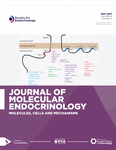Emerging functional roles of nuclear receptors in breast cancer
-
Figure 1
(A) Schematic diagram of the structural and functional organization of nuclear receptors (reprinted by permission from Macmillan Publishers Ltd: Nature Reviews Drug Discovery (Gronemeyer et al. 2004), copyright 2004). The evolutionary conserved regions C and E are indicated as boxes (green and orange, respectively), and a black bar represent the divergent regions A/B, D and F. Domain functions are depicted above and below the scheme (AD, activation domain; AF1, activation function 1; NLS, nuclear localization signal). (B) Hierarchical clustering of NR tissue expression profile (reprinted from Cell, volume 126, Bookout AL, Jeong Y, Downes M, Yu RT, Evans RM & Mangelsdorf DJ, Anatomical profiling of nuclear receptor expression reveals a hierarchical transcriptional network, pages 789–799, copyright (2006), with permission from Elsevier). The relationship between receptor expression, function and physiology is depicted as a circular dendrogram using the hierarchical, unsupervised clustering of NR tissue expression distribution profiles in mouse. The analysis reveals the existence of a higher order network tying nuclear receptor function to reproduction, development, central and basal metabolic functions, dietary-lipid metabolism and energy homeostasis. The NRs in red boxes are discussed in this review with a focus on their functional roles in circadian regulation, metabolism and breast cancer migration and metastasis.
-
Figure 2
The molecular clock machinery (reprinted from Trends in Pharmacological Sciences, volume 31, Bechtold DA, Gibbs JE & Loudon AS, Circadian dysfunction in disease, pages 191–198, copyright (2010), with permission from Elsevier). The molecular machinery that provides circadian timekeeping consists of a complex circuitry of transcriptional/translational regulatory feedback loops (clock components shown in gray). In mammals, the current model involves a primary loop with CLOCK (or homologue NPAS2) and BMAL1 as transcriptional activators, and PERIOD (PER1, PER2 and PER3) and CRYPTOCHROME proteins (CRY1 and CRY2) as transcriptional repressors. As levels of cytosolic PER and CRY proteins rise, they associate, translocate to the nucleus and repress their own gene transcription through direct interaction with the CLOCK/BMAL1 complex. This feedback cycle provides near 24-h timing and drives the rhythmic expression of several clock-controlled and clock-modulated genes, which in turn mediate circadian rhythms in behavior and physiology. Acting on the primary feedback loop are auxiliary loops, which appear to increase the stability and robustness of the oscillations. The most notable interlocking loop is that involving the nuclear hormone receptors (NRs), REV-ERB and ROR. In addition to REV-ERB and ROR, several other NRs (shown in green) interact closely with the circadian feedback loops and are responsive to the clock (exhibit rhythmic expression) and able to feedback onto the clock genes themselves. NR regulation of clock genes also renders the clock responsive to numerous circulating hormones (e.g. cortosol, estrogen), nutrient signals (e.g. derivatives of fatty acids and retinoids) and cellular redox status (NADH/NAD+ ratio).
- © 2017 Society for Endocrinology











